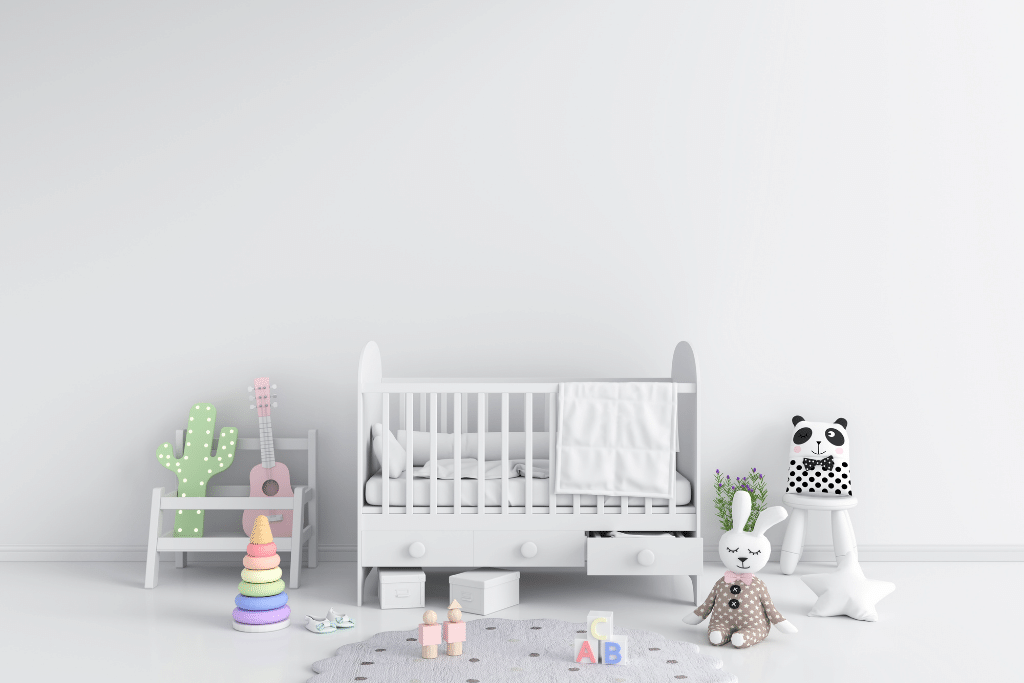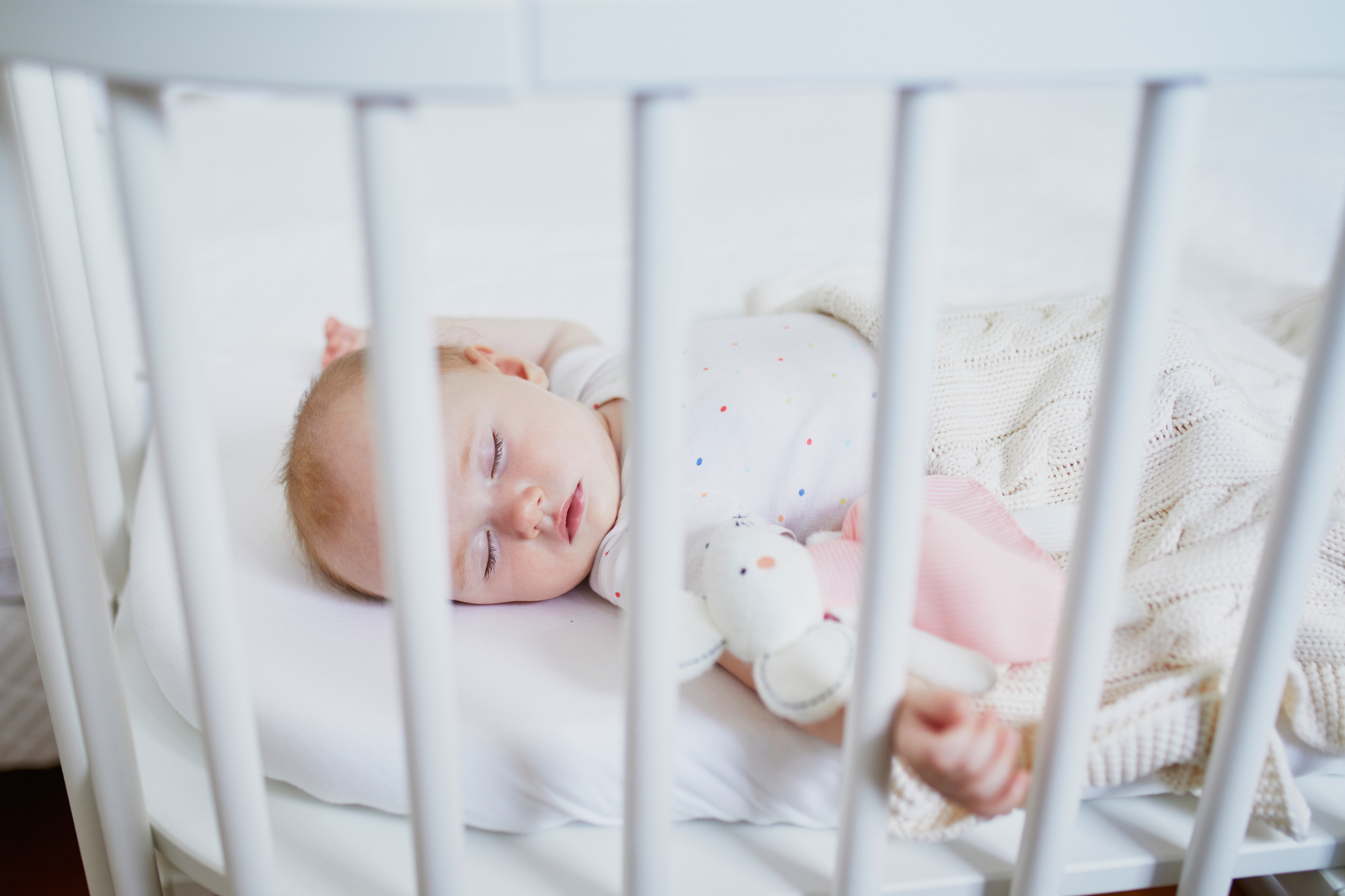When you become a mother, you realize there’s so much to learn. For example, you might be curious how to take care of an infant best, choose between a crib or bassinet for a newborn, and transition your baby to a crib.
The list is endless, and it can feel overwhelming. But, the good news is that you are not alone!
I am here to guide you on this journey, and today, I’ll help you learn how to transition your baby to a crib.
This process can be challenging for you and your child. However, if you were previously using a bassinet, you are probably accustomed to having your baby in sight all the time, and this assures you they are safe.
The thought of them now sleeping in their crib in another room can be nerve-racking. However, you can use tips to make the process smoother, and we’ll look at them in this article.
When Is The Right Time To Transition Your Baby To A Crib?

Before we look at the transition to crib tips, it’s important to know whether your baby is ready for this significant change.
There are things you should consider to help you make this decision.
How old is your baby?
When should a baby start sleeping in a crib? The answer is right from the time they are born.
Many parents prefer using the bassinet first because it’s tiny and so you can get amazing bassinets for small spaces. They are also portable and can be attached to the bed to enable you to monitor your baby even at night, not to mention the convenience of checking on them, changing their diapers, and so on without getting off your bed.
If you plan to use a bassinet first, it’s good to know when is the right age for your baby to move to the crib.
Many babies are ready for this change between 3 to 6 months old. However, this varies from one child to another because of different growth rates.
Indeed, babies can’t use bassinets when they are past six months old because the bassinets cannot accommodate their weight. So, if you have doubts, plan to move your baby to the crib around the six-month mark.
Your baby’s height and weight
Your baby might be younger than six months, but a bassinet might no longer be a good option if she is growing fast. The bassinet might be too tight, so the little one might start waking up more frequently at night.
If the baby moves too much at night, it might signify that the sleeping space has become too small.
Your child might have also grown past the weight limit for the bassinet. For example, if the manufacturer indicates that a bassinet can accommodate a maximum weight of 20 pounds, then if your baby gets to 23 pounds, it’s no longer safe for them to use the bassinet.
In both of these cases, you should consider transitioning the baby from bassinet to crib.
Can your baby sit up or roll over?
If you notice your baby can sit up on the bassinet on their own or move positions, it means they’ve outgrown it, and it’s time to move to the crib.
It doesn’t matter if they are 3 or 4 months old or if they are still within the bassinet’s weight limit, the next step should be transitioning baby to the crib.
The reason is that the bassinet sides are usually low, so the baby can fall out of it as they move around.
Tips On How To Transition Baby To Crib

Now that you know it’s time to make this huge change, how do you do it?
Let’s look at how to transition the baby to the crib in a less stressful way for both you and your baby.
Make the crib comfortable
You need to prepare the crib before you transition your baby to it.
Is the mattress firm? According to the American Academy of Pediatrics (AAP), soft sleeping surfaces or beddings can cause suffocation and increase the risk of Sudden Infant Death Syndrome (SIDS). Therefore, as much as you may think your baby will be comfortable in a soft mattress, it’s wise to avoid it.
Is the crib sturdy enough to accommodate your baby? Your baby’s safety is important, and you will also have peace of mind knowing the crib won’t collapse with them inside or anything like that.
Are the sheets clean and soft? Are they warm or cold? You should consider these things because they will quickly adapt to sleeping in a crib when your baby is comfortable.
If your baby is more than a year old, you can let them sleep with their stuffed animals, but not when they’re younger because it can lead to SIDS. This is according to AAP.
Make the transition gradual
Imagine getting used to sleeping in your bedroom, and then one night you wake up, and you are in another room. This could be scary.
While some babies adjust to change instantly, others take time and rushing the process only makes it more difficult. That’s why you need to introduce small changes. For example, you can have the crib in your room or next to your bed for a few days. Yes, they’ll notice they are sleeping in a different bed but also be comfortable because they are in the same room they’ve been sleeping in.
After they’ve gotten used to the crib, you can move the baby to their room, together with the crib.
You can also start by letting them sleep in the crib during the day for a few weeks and in their bassinet or usual sleeping area at night. Then, after they’ve gotten used to the crib, you can let them sleep in it at night.
You can also put the crib sheets in the bassinet to get used to sleeping on them first before moving them to the crib. The options are endless.
Stay with them in the nursery for a while
One of the best things you could do is to spend time with your baby in the nursery before moving them in.
You can play games, read them storybooks, change their diapers, or do fun activities with them in the nursery or where you plan to put the crib. This will help them to be familiar with the room and have good memories of it. Therefore, they will have less resistance to sleeping in it at night.
When they finally start sleeping in the crib, please don’t put them down and immediately leave the room, at least for the first few weeks.
Find a reason to stay for a while so they can relax instead of leaving them wailing. For example, if you have a chair or bed in the nursery, you can be on it and keep them company until they are sleepy.
Introduce a sleeping routine and stick to it
Children are different from adults in that children thrive on routines.
Introducing a routine at night will help your baby know it’s time to sleep. For example, you can have dinner, bathe and massage them, take them to their crib, and read them a storybook before they sleep. Therefore, after they have their supper, they know what’s next, and they’ll be less likely to give you a hard time during bedtime.
Remember the point I made to stay with them for a while in the nursery? This can be part of your night routine which is an excellent solution for how to transition baby to crib. For example, the massage, reading of storybook or singing can happen in the nursery. This will make them excited to always get to their crib.
Monitor your baby
In the beginning, when you are learning how to transition baby from co-sleeping to crib, you might find it difficult to relax when they are in their crib. You might have images of them throwing the blanket off and being left in the cold or their leg getting stuck between the crib rails or worse.
Monitoring your baby will give you peace of mind because you will see that they are safe. This will also prevent you from interfering with the process of transitioning the baby to the crib.
There are various ways you can monitor your baby:
- Video monitor – You will see your baby on the video receiver. You’ll also hear any sounds they make.
- Audio monitor – This one captures your baby’s sounds so you’ll know whether they are turning and tossing, sleeping, awake or crying.
- Wi-Fi monitor – Technology has evolved to a point where you can connect your smartphone to a baby monitor and keep an eye on your child. This means you can monitor your baby even if you are out of the house.
Don’t rush to your baby’s side the minute they cry
This might be the most challenging tip to implement and can even seem cruel, but I assure you it’s not. First, you need to trust the process.
According to research, it is normal for babies to cry while sleeping.
Infants sometimes struggle to adjust to a regular sleep pattern. Therefore, they may make sounds like screams, grunts, or cries. Unfortunately, when you rush to their side each time this happens, they won’t be able to go back to sleep on their own, and you will need to pick them up every time they do that.
I don’t advocate for neglecting them when they cry. You can peep to see if the baby is in pain or seems sick. You can also see this from a baby monitor. Don’t go into the room when you are sure they are just making those sounds while sleeping. They’ll go back to sleep shortly afterward.
Your baby’s age greatly matters when applying this tip. For example, you can’t ignore a newborn when they’re crying, but a one-year-old will find themselves getting back to sleep.
Allow them to self-soothe
As the name suggests, this refers to letting a baby calm themself down. Our first instinct is to soothe our babies whenever they are anxious. However, it is pretty powerful for them to do this on their own.
There are so many benefits of self-soothing for kids, such as the ability to manage their emotions, help them sleep better (because they can get themselves back to sleep) and even create healthy relationships later in life.
One way of helping your baby self-soothe is by putting them in the crib when they are sleepy and allowing them to fall asleep on their own. When they learn this, they can do the same when they wake up during the night.
The tip we mentioned previously of not rushing to their side when they cry is another way of training them to self-soothe. Since they know no one is coming to soothe them to sleep, they’ll learn to go back to sleep by themselves. If you can’t stand not running to their rescue when they cry at night, you can go to their crib and pat them while they’re in it, and they’ll fall asleep again as opposed to picking them up.
Take it easy on yourself
You can also struggle with letting your baby sleep in a different room because you used to have your baby close by.
Remember to go easy on yourself because you also need time to adjust to this change.
It is normal to get emotional and feel like abanding the whole process. However, this is not the solution. If your baby starts sleeping in their crib and maybe is about to get used to it, you take them back to your bedroom. It will confuse them. It will also make it harder for them to adjust later on when you again transition them to the crib.
Final Thoughts
Knowing how to transition a baby from bassinet to crib can seem stressful. However, it doesn’t have to be. Just go for it, go for it once you are sure that it’s the right time to transition your baby to the crib. Then, you can apply the tips discussed here, such as preparing the crib, making the process gradual, using baby monitors, and allowing them to self-soothe. I hope this answers your question on how to transition baby to crib. Read this article if you’d also like to know how to choose the right stroller for your baby.
Hi – I’m Alina and I am a soon to be mom going through the journey of becoming a parent. I am a writer at heart and I love sharing about pregnancy tips and other busy mom hacks.
